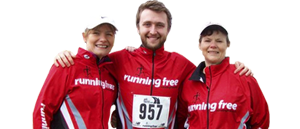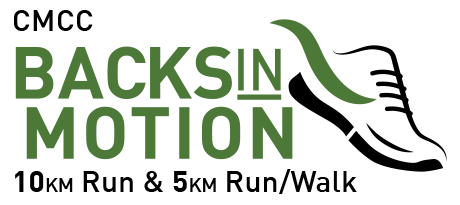2011 – The Year of the Cramp
A recent article “Stop Seizing Up” by Alex Hutchinson in the September edition of Canadian Running has got me thinking. Just what has been going on with all the cramps I have been suffering this year? Why me and why now? What exactly has changed? The timing of the article could not have been better, as I am once again off the training circuit due to a cramp-related injury.
Most think of cramps as something that happen during the later stages of long hot races. They have typically been attritributed to improper hydration and salt balance. Electrolyte based fluids, salt pills, and bananas are the runner’s prescriptive to avoid cramps. It ensures the two nerve signals that initiate and inhibit muscle contraction occur at the correct timing and in appropriate amounts. When this balance is lost, then uncontrolled contractions such as cramps and spasms can occur.
This was the old line of thinking, that cramps are electro-chemical by nature. We think if we get our hydration and salt replacement right, we will avoid cramps. But perhaps, more accurately, our strategy has been to delay the onset of these unwelcome visitors. This thought is an important difference, because our training and racing tactics (although we might not realize it) are tuned to do just that: to delay the onset of cramps, at least until the moment we cross the finish line.
The New Theory on Cramps
Alex Hutchinson reported on new research that suggests cramps are a mechanical process, and that hydration has little to do with how cramps are formed. Rather cramps are the result of overwork and damage to muscle tissue – something that we can control through proper training and racing strategy. This also explains why the most stressed muscle groups in runners are prone to cramps: hamstrings, calves and quads – generally in that order.
But the idea that cramping is only mechanical is not quite right. If cramping was purely mechanical by nature, then dehydration would not be a major factor. Further, if you put some dude into a sauna or hot yoga session he would either not cramp or cramp in strange random places.
Dan’s Own Theory on Cramps
I think we are better served by drawing these two sides together, because it explains many things. Cramps are likely the culmination of both mechanical and chemical issues. Both factors in varying amounts must be present for cramps to form. To understand this from a different perspective, let’s take a look at the ice cube, specifically how ice forms.
We know that ice starts to form when water is cooled to 0C and then cooled further. At this point, a small crystal of ice will form, and then from that crystal another will form and then another. It all starts from that first crystal, which requires something to trigger its formation. This is typically an impurity such as a dust spec (we can think of it as defect) in the water itself. If there are no such defects, the ice will not form, at least not immediately.
Now let’s put this together in terms of our cramp. First you create the chemical conditions necessary for a cramp to happen – salt imbalance, dehydration. If you are just sitting in a sauna, chances are no cramps yet. If you went out for an easy 5k, again chances are no cramp (unless you are me). But 35k into a marathon on a warm day, and you overstretched your hams before starting? Now here is a recipe for a cramp (again just like me). That recipe would include muscles that are overworked, injured during the race or already had defects due to poor training or overzealous stretching (yep, me again).
Now, back to the poor dude sitting in the sauna. What if he did manage to stay in there long enough until something cramped? What is the only muscle in his body presently doing any real work? My money is that it would be his heart that would suffer the cramp, and that would be deadly. Poor bugger, he should have read this article.
Training and Racing Strategy to Reduce Risk of Cramps
So if we are going to have a successful race, we need to avoid getting cramps, or at least defer their onset until we have crossed the finish line. Aside from maintaining proper hydration, our best strategy then lies with staving off muscle damage for as long as possible. And herein lies the art of perfecting our racing and training. Start off too fast, and our muscles will be damaged earlier giving more opportunity for cramps to take hold. An overly ambitious pace beyond your present training level will have the same undesired consequences.
Knowing exactly how much to gamble is the key. Go for broke if you desire, but if it was too much, then a cramp will tell you so. This is where having a coach or talking over your strategy with other seasoned racers can save you from your own foolish ideas. Look up a good training plan, which will indicate target weekly distance, long run distance (done easy) and speed work – all laid out at paces necessary to achieve your race time. Better yet, get into a running group such as Ajax Running Free and match yourself up with someone training at your pace. There is nothing better than knowing your friend’s PB will soon be yours too (right Johnny?).
A related strategy is arriving at the start line without any defects in the first place. And there are simply too many training errors to mention, truly a topic in itself. But I will mention a few: ensuring adequate recovery (very easy runs) before and after each hard training day, a well executed taper before the race, and always adequate sleep to make sure recovery actually happens. And let’s not forget what we have been eating.
So What Was I Doing Wrong?
My RMT is shaking his head right now. So let’s answer my own question, and hopefully save my RMT’s thunder in my ears. My own training errors leading to my most cramped-filled year on record include:
- Believing I can return to my most fit state ever without a good training plan with lots of intermediate goals.
- Going after PB times I am not ready for (see item 1).
- Going out too fast in my races (see item 2).
- Poor sleep, leading to ineffective recovery (even with easy days religiously observed).
- Running hard days too fast (paces guaranteed to court injury – see item 1).
- Poor stretching, not that my hams could be stretched due to poor sleep (see item 4).
Cramps During Races
So if you do start to cramp during a race, what should you do? Well, if it isn’t a MUST FINISH race (and few are) stop and walk off. Get assistance to get back to your gear and warm clothing. The fact is, major damage is imminent, so why risk it? You pre-paid a lot of races, so no sense holding a sell-off. Save yourself for your next race, before it is too late. Once home, review your race tactics and training. The cramp is a good indicator who have exceeded your limits in some aspect. Make some adjustments, and hopefully next time you will nail it.
As soon as you feel tightening, and know you must finish, then the sooner you act the better. First, write off your goal time, because that is no longer going to happen. Be happy just to finish with a time that is still respectable. Next, attempt to slow down but do not stop, and if you can’t jog slowly then walk. The movement of your legs is actually assisting with circulation which is helping to keep electrolytes moving to where they are needed. You may have noticed many runners cramp terribly just after they finish – this is why. So if you must stop, just face it, your race is likely done. Also, stretching now is a poor idea due to likelihood of worsening the damage. Get more electrolyte fluids in you, take salt tablets if you have them. It may take 10 minutes of slow jogging, but if you have adjusted enough before significant damage has occurred, the cramp will settle and you can gently pick up the pace – once you are within striking distance of the finish line.
Now a word on hamstring cramps – my newfound buddies. The hamstrings are typically called upon twice during the running gait cycle. Once to propel the body forward: as the muscle contracts the leg moves in the direction of the contraction. And again during the forward stride to arrest the forward motion of the leg: as the muscle contracts the leg is moving against the direction of the contraction, known as eccentric contraction. Eccentric contraction is very hard on the hamstring muscles, and it can be managed by controlling stride length. The longer your stride, the greater the eccentric contraction response. So if you are beginning to feel tightening in your hams, the first and most important thing to do is to shorten your stride length, and if possible increase turnover rate. Many elite runners understand this, and are adept at keeping cramps at bay until the finish line is reached – without sacrificing all that much on their finish time.
Cold Cramps
A final mystery is how I could possibly cramp 15k into a half marathon on a cold day with wet pavement. Clearly there was no electrolyte loss leading to chemical imbalance – or was there? Our body is designed to operate at 37C plus or minus a degree. The complex chemical reactions firing our nerves, necessary to transmit those signals controlling our muscles, do not function well when tissue gets cold. Everyone has gotten numb fingers on a cold day. Ditto for my hams, which were constantly getting kickback from the wet road. There was also a considerable stretch of downhill and I was overstriding. The recipe is now perfect: overworked muscle (due to eccentric contraction) and a chemical imbalance (inhibited nerve signals).
Avoiding cold cramps is simple – wear some leggings if it is cold and wet. And if running downhill, keep an eye on that stride.
Dan’s Most Memorable Cramps
No. 1: Scotia Waterfront 2004 – 35k into my first marathon, both quads. I deserved this one. Averaged 50k/week training (if that) for 8 weeks, did only 2 long runs over 30k. Went out at 3:10 marathon pace, still managed 3:21 (missed my BQ which I thought was a gimme). Swore off marathons forever.
No. 2: Toronto Marathon 2009 – From 32k I knew I had my first sub 3h in the bag, so played it safe until 40k then drained the tank. Right ham cramps 20 m before the finish – couldn’t have executed better! It was 6C and I had worn my tights, a 2:58 was mine.
No. 3: Toronto Half 2011 – From 8k on left ham tightening, shortened stride but by 15k I was done. My first DNF race. Pace too ambitious (trying to repeat my 2010 PB), hams just too wet and cold. Shouldn’t have worn shorts.
No. 4: 20 Valley Half 2011 – Decided not to go for broke. Seriously hot and hilly. So changed goal pace from 3:45/k to 4:00/k and took home top masters. This one time, I kept my pace to training plans and course conditions. A great reward. And no cramps!
No. 5: 2011 Endurrun Marathon: Conditions were not right to push 4:00/k goal pace (warm and hilly) but I did anyway. Ham started to tighten at 19k and cramped by 30k. Had already shortened stride, then took a very slow jog for 4k, then was able to pick up pace a little after a salt tab took effect. Managed to finish 3:01 – and still first across the line! The finish also locked up a 2nd place relay team result – which is why I had to finish.
If you have read this far, I wish to apologize for having to put up with me for so long, and thank you. Hopefully, you will learn from my mistakes and avoid them (the cramps that is!). Maybe my RMT will print this article out and make me read it, cause he won’t believe I wrote it. In any case, please excuse me now, I am seriously bummed out cause I can’t run – I am going to sit in a sauna for a few hours.
About the Author
Although he has a Master’s degree in Biomedical Engineering from the University of Toronto, it is quite likely Daniel has no clue what he is writing about. If you are suffering from cramps, have a professional examination – there may be underlying reasons for your issue, and you might just avoid a season/career ending injury.



















Hi – thanks for this article. I have been suffering cramps in my last 2 marathons and I have no idea why all of a sudden I’m experiencing these and it’s driving me nuts. The worst is the moment when the cramping starts during the race and I feel helpless and see all those months of training go down the drain. 🙁
My doctor told me it might have been because of a hilly route, which kind of matches your theory of the long strides etc. But my last marathon (and the worst cramping episodes ever!!) was on a very flat route. So… huh…
Anyway, you mention that you think it’s a combination of chemical and mechanical… but you emphasize a bit more on going out too fast or extending/pushing your muscles further. How about nutrition? Did you assess your nutrition? With all the extra training, do you think you didn’t feed your body enough to push your body further? I ask because upon my own personal analysis, I’m leaning to the idea that maybe it was a lack of good nutrition that caused my cramping grief!
Thanks!
Dan, great article. Given a short stride, lots of fluids and tonnes of electrolytes, how does one race a long course event without cramping. I find maintaining a sluggardly pace will keep the cramps away, but it keeps the podium away too. Still searching for the right combination of training, fluids, electrolytes and race pace. Let me know if you find it.
Hope ur feeling better soon,
Jim McLellan
PS – short course rocks! Lol.
You might say I am learning the hard way… It would appear the body has a finite stress limit, with those stresses coming from training/racing, sleep, nutrition, toxins (beer!), work, family, etc! Cramping is a symptom that those limits have been exceeded.
The tougher your training the more recovery is required. The recovery available is a function of life’s other stresses. Training/racing in excess of available recovery leads to break down, including cramps, tissue failure, stress fracture…I am still paying for all my 2010 races.
Take a look at how much you have trained, and try to pin point other stresses that have entered your life. A good amount of stress should be counteracted by great nutrition, which is why I now understand its importance.
I often find it tough to eat before a marathon. The only tactic I can suggest here is to start eating and carbo-loading sooner, ensuring you are drinking enough water for the carbs you have taken in. If it comes out looking the same way it went in, then there’s a good sign the digestion is not working for you.
We sometimes cannot control our salt balance and water before a race. There is no harm carrying a few salt sticks with you, as I have learned from a successful cramp avoidance pacing the Scotia full.
Hope all this helps!
Jim, my RMT and I suspect that all my issues originate in weak gluteus muscles. This weakness has over time forced other muscle groups such as the hamstrings and calfs to over compensate (i.e. get overworked to the point of failure). With this in mind, please consider the following.
Getting each muscle group to do its fair share of the work is the key, a key which is likely more important for tri-sports. It makes good sense that the swim section should favour arm work – strong kickers would already have tired legs when they leave the water. Likewise, there are slightly different muscle groups used for biking and running, but the differences can be less obvious, as many muscles are common to both. Do you pull or push when you peddle? 50/50? Are your ankles stiff or flexible, i.e. how hard is your peddling working your calfs?
I would assess exactly what is cramping, and then attempt to transfer some of the work to other muscles if at all possible. This might mean very small adjusments in peddling technique or running stride or both.
Another avoidance tactic would be to train the muscles so they are capable of the racing long durations without cramping – this of course means increasing long days and overall weekly volume, provided your body is not pushed beyond its stress/recovery limits.
I am not a tri-athlete, but I have done some bike/run combos in the fitness centre. I have a high probably of calf cramps within 30 seconds of starting on the tread mill. I have not played with it, but I suspect the transition time between the bike and the run is crucial. It would appear important to minimize this time and to keep the legs moving through the transition. These cramps are loss of inhibition (chemical) and I would suspect that a quick dose of electrolyte with an antagonistic muscle flex will clear these types of cramps quickly so that movement can resume. I can’t help but think hydrating or a salt tab taken prior to transition would be a good preventative tactic if timed well. I presume there is a good reason tri-athletes practice brickwork (bike to run transitions), as you need to know what will work for you on race day.
Likely all things you know very well…some of the above not more than guesses on my part. Let me know if this makes sense.
Hi Daniel;
Found your article on cramps very interesting, but I have to wonder. Do you experience cramps during training runs (long steady distance or interval training sessions)? If not then I would rule out a mechanical issue, however that leaves physiological. So since the muscles only get what you feed them. I have to wonder about your dietary intakes and whether your mineral intake is appropriate to the stress you place on your skeletal system as well as the protein and quality of the protein. As an athlete I am fortunate to have escaped the debilitating discomfort of cramps while training or racing, however I have always been aware of my nutritional status and ensure my body has the correct amount of substrate from which to function.
As an aside, I also watched your video regarding arm swing,position and running style. I did notice in the endurrun video your left thumb was thumbs up in every shot. I also noticed you carry your left arm in an almost perfect 90 degree bend and with very little motion as opposed to your right arm in which your elbow bend is significantly more than 90 degrees and the arm appears to track in a different path from the left, how would you propose a correction for that bilateral asymmetry to another runner?
I look forward to reading other articles you have written and have yet to write!
To Daniel K:
Thanks for your thoughts and suggestions. My main solution right now is reducing over work of my hamstrings through strengthening of the glutes, and moving the touchdown of my stride closer to right under me. So far, so good.
Cramps during training have not been any problem, like due to the lower stress levels relative to racing paces. However, my tendancy to blow up during tempo runs and track sessions is duly noted! These are in fact one of my major training errors: forcing hard sessions too close to races or other overly exerted activities.
I have become quite aware of nutrition. The idea of high quality protein supplement (such a one of the Vega supplements) is on my todo list. Thanks for this suggestion!